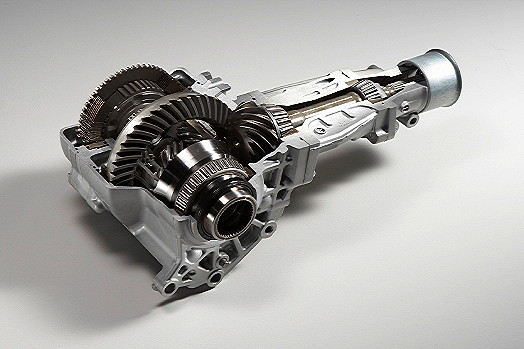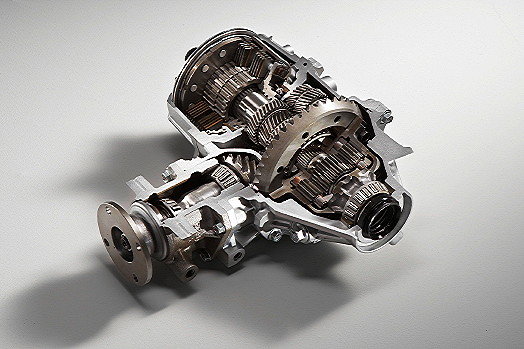Mitsubishi has taken a bold decision: it’s decided that the Evo doesn’t have enough acronyms associated with it. AYC, ABS, ACD, MR, FQ, MME, MMC – and who knows what else – don’t cut it, so when the Evo X arrives in October we’ll have three more abbreviations to deal with: ASC, S-AWC and SST.
The first two should make the Evo X grippier and more stable than any of its predecessors, while the last one is set to make it an easier car to drive – and perhaps a faster one, too. Let’s take a look at each one.
ASC: Active Stability Control
Evo X Bluffer’s Guide: The Acronyms Explained
S-AWC – Super All Wheel Control Mitsubishi’s new integrated all-wheel drive system brings together the management of several different vehicle dynamics systems.

ACD – Active Centre Differential Balances between optimum traction and steering
ASC – Active Stability Control Kills wheelspin and stops skids before they start

AYC – Active Yaw Control Manages the car’s rate of turn in curves to match the driver’s demands

Sport ABS Uses yaw rate and brake pressure sensors for improved performance in corners

SST – Sport Shift Transmission Twin-clutch gearbox gives fast changes and high efficiency
Electronic stability control systems apply the car’s brakes at individual wheels to kill wheelspin and to correct the attitude of the car in a skid. These systems have become more and more common over the last 10 years, and earlier this year Euro NCAP called for them to be standard on all new cars. So far the Evo has done without, but that changes with Evo X.
Mitsubishi’s ASC system reduces wheelspin by regulating engine power and applying the brake on a spinning wheel. A brake pressure sensor is fitted at each wheel to allow precise control of braking force. Though applying the brakes like this might sound like it simply slows the car down, it can actually improve acceleration: because of the action of the differential, applying the brake on one spinning wheel allows more torque to be transmitted through the opposite wheel.
S-AWC: Super All Wheel Control
The new ASC system is part of a sophisticated ‘vehicle dynamics control system’ which Mitsubishi calls Super All Wheel Control. The system integrates the control of ASC and the systems familiar from previous Evos – Sport ABS, the Active Centre Differential (ACD) and the Active Yaw Control (AYC).
As before, ACD uses a hydraulic multi-plate clutch to automatically adjust the locking action of the centre diff to optimise traction (which needs a locked diff) and steering response (better with an open diff).
The AYC system acts as a limited-slip device in the rear differential, and in addition it transfers torque between the rear wheels to control the Evo’s yaw rate – the speed which it rotates around its vertical axis as it goes through a corner. For Evo X the system has been given a yaw-rate feedback control for more accurate operation, it also gains brake force control which Mitsubishi says expands its capabilities.
The Evo X’s Sport ABS system benefits from the four-wheel brake pressure sensors and the yaw rate sensor built into the S-AWC system: Mitsubishi claims it has improved performance in corners compared to the ABS system fitted to the Evo IX.
Mitsubishi’s engineers must have had their work cut out to make so many inter-related control systems work in harmony to produce a responsive but predictable chassis. It’ll be interesting to see just how successful they have been.
SST: Sport Shift Transmission
Mitsubishi’s new six-speed Sports Shift Transmission will be an option on the new Evo. Developed in-house, the new transmission provides lightening-fast gearshifts while retaining the high efficiency level of a conventional manual gearbox.
Though Mitsubishi has denied that SST is related to Volkswagen’s DSG transmission, the two are similar in layout. The key to the system’s rapid gearchanging is its twin clutch-engaged input shafts – the first carries first, third and fifth gears, while the second shaft carries second, fourth and sixth. While one gear is in use, the gearbox control computer can pre-select the next gear on the other shaft. When a gearchange is required, the clutch on one shaft is opened and the other closed.
Unlike a conventional automatic, the SST does not need a hydraulic coupling with a torque convertor – and that means the power loss through the transmission is similar to a conventional manual ’box.
SST has three drive modes. ‘Normal’ shifts at fairly low engine speeds to maximise comfort and economy. ‘Sport’ uses higher shift points and quicker shifting, and is ideal for country roads and where engine braking is required (while Mitsubishi also claims it ‘instills in the driver a closer man/machine relationship’). ‘S-Sport’ delivers ultra-fast gearchanges and keeps the engine turning at high revs for instant response.
If Volkswagen’s twin-clutch ’box is anything to go by, SST could be a major step forward for the Evo. Super-fast gearchanges and an easy-to-drive auto option should make the Evo quicker and at the same time widen its appeal. We’ll soon see.
